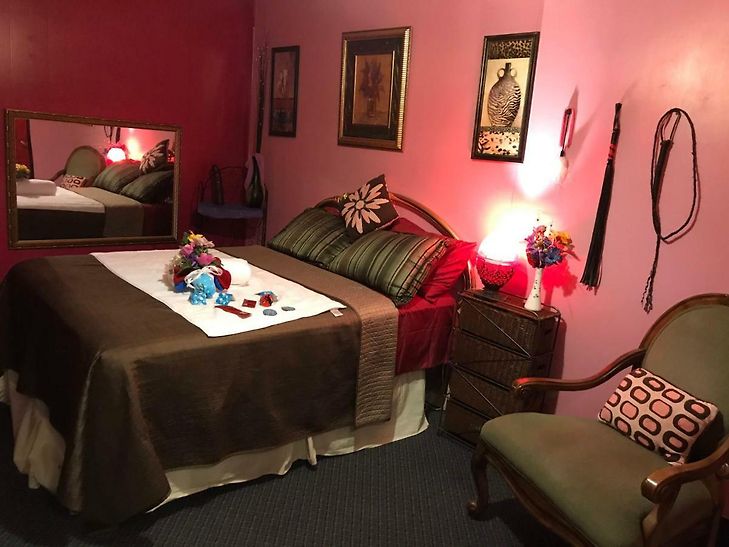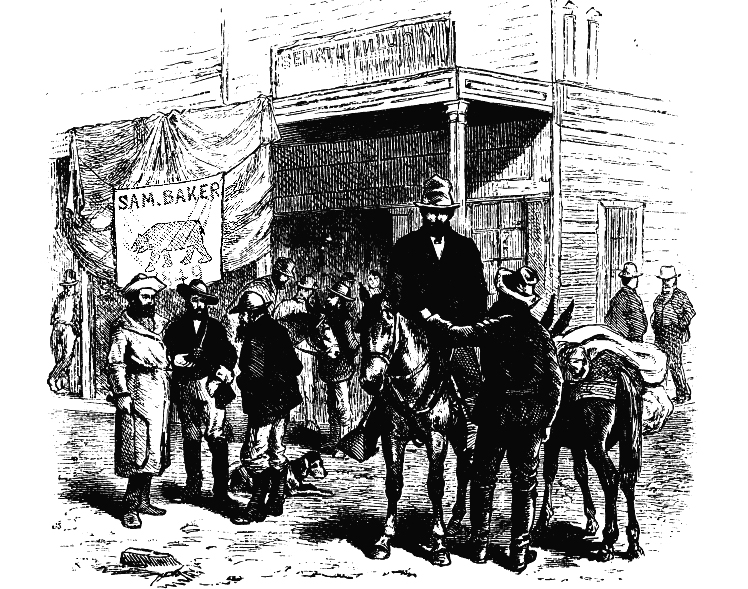Copyright 2020 by Gary L. Pullman
Like
the frontier itself, the newspapers of the Wild West weren't all that
tame. Whether the content was news, entertainment, or even
advertisements, the material was apt to be intriguing. Sometimes
sensational, occasionally humorous, and, more often than not, a bit
tongue in cheek, the newspapers' stories, like its promotional
copy, were welcome in prairie towns, on the high plains, and in
wilderness locations far from home or, for that matter, civilization
itself.
Newspapers
allowed men and women on the frontier to keep abreast of what was
happening in the rest of the country and enabled them to receive
goods they couldn't always easily find in their own communities, if
at all.
A
survey of even one newspaper of the wild West shows fairly well what
the others of its kind printed for its eager readers and, in our own
day, offers us a glimpse of the life and times of the men and women
who braved life on the edge of American civilization. Occasionally,
the advertisements especially show the more devious side of human
nature as well, just as the humor pokes fun at the absurdities or
personal and social behavior.
The January
19, 1895, issue of The Courier,
a newspaper that provided more entertainment than news, it appears,
bore, among its other sundry contents, George Moss's light verse, “A
Half-back from Wayback,” concerning a dude lately arrived on
the Western frontier. The tenderfoot in question is “a young Yale
graduate” who has taken the suggestion, attributed, by Josiah
Bushnell Grinnell, its alleged recipient, to famed newspaper editor
Horace Greeley, and gone West—in fashionable dress, yet:
He was a young Yale graduate
And he hied him to the west.
Oblivious of fear or fate
And fashionably dressed.
He
ends up in Santa Fe, at “Dutchy's restaurant,” where he catches
the eye (or eyes) of several frontiersmen who, each independently of
the other, but unanimously, decide the newcomer “must go”:
He landed out a Santa Fe
And captured the town by storm,
Though naught he said, or didn't say
But chiefly because of his form.
On night in Dutchy's restaurant
Assembled a famous crowd:
Shanks, Deep Gulch Mike and Sandy Grant;
Red Thompson and Aleck Dowd.
A lawyer chap they called the Judge,
And Billings of Navajo;
Each pledged the other in Dutchy's budge
That the tenderfoot must go.
When
the dude refuses “big
Aleck Dowd's offer to have a drink with him, Dowd jerks his gun,
demanding that the Easterner change his mind; instead, the tenderfoot
disarms Dowd, breaking both the gunman's arm and the mirror into
which the rowdy's liberated pistol flies:
Then Dowd, advancing, pulled his gun
And remarked in sneering tones:
“You'll take a drink, or they'll be fun,
Likewise some blood and groans.”
And sudden as the lightning's flash
Our youth worked the elbow charm;
The pistol flew through the mirror, crash!
And Dowd had a broken arm.
One of the others, Shank, by name, next flings himself
upon the newcomer and is tackled for his trouble, while the intended
victim's knee causes a third attacker, Billings to throw “up
blood.” Apparently, the dandy fells Deep Gulch Mike, who splits his
head open “on a stone spittoon.” Sandy Grant is knocked out, and
Red Thompson, now thoroughly unnerved, beats a hasty retreat. Only
the lawyer among the attackers is left, but the tenderfoot soon
dispatches him, too, tossing the attorney over the restaurant's bar.
Amazed, Pete, the bartender, asks his guest how he
managed to defeat seven of the West's worst scoundrels. If the poem's
title hasn't given away the punchline, the student's reply makes
clear the incident's “snapper”: “They were easy meat/ I've
played on our football team.”
Wild though it may be, the West, it seems, is no match
for a Yale Tiger!
The
Courier itself, which was
“published
every Saturday” in Lincoln, Nebraska, offered itself at the
rates of $2.00 per year, $1.00 for six months, 50 cents for three
months, 20 cents for a month, or five cent per single copy, promising
subscribers that only “a limited number of advertisements will be
inserted.” The copy posted by The Library of Congress on its
Chronicling America
website doesn't bear out the veracity of the vow: five of the issue's
twenty pages, or twenty-five percent of the publication, contain
advertisements.

The
advertisements, which might not have been of great interest, in their
day, to the newspaper's readers, are more intriguing today, perhaps,
now that time has put some distance between the wild and woolly West
of yesteryear and the high-tech times in which we live our lives at
present. The grocers Hotaling
& Son make it clear that they cater to “family trade only,”
as a consequence of which “their goods are the nicest and freshest
in the market,” suggesting that, were they to deal also with
commercial trade, their sundries might not be quite as nice or fresh.
Likewise,
the Merchant's
Hotel in Omaha pays “special attention to state trade, guest
and commercial travelers.” The rest, we guess, can go to hell.
Presumably,
Drs. Starkey & Palen, who offer to heal the sick and make strong
the weak, have themselves been “sick or debilitated,” because, it
is from their “own experience of twenty-five years” that they
know that their Compound
Oxygen is not just another dubious remedy, but one that actually
works, and, to prove it, they offer a two-hundred page volume that
details, with “numerous testimonials,” the efficacy of Compound
Oxygen, not of its cures, mind you, but of its “cues” of no end
of complaints, including “asthma, beonchitis [whatever that may
be], consumption, catarrh, rheumatism, nervous prostration,
neuralgia,” and whatnot. The physicians conclude their
advertisement with a cautionary statement, urging readers to avoid
fraudulent imitations and “disappointment and loss of money, as
there is but one genuine Compound Oxygen.”

If
a reader would rather have something perhaps a little stronger than
Compound Oxygen, a neighboring advertisement recommends Old
Elk
Bourbon, which, perhaps, unlike some of its competitors' whiskey,
is shipped pure and unadulterated direct from the distillery,”
presumably to prevent any middlemen from introducing impurities or
other adulteration. Not just one or a few, but “the medical
fraternity everywhere,” wherever that may be, has endorsed Old Elk
as a life-giving elixir that gives, if not a cure, “life, strength
and happiness to the weak, sick, aged and infirm.” The bourbon
should, but may not, be available at either the pharmacy or one's
local “liquor dealers”; if not, no matter: it can be obtained
from the distilleries themselves. For $1.50. in advance, Stoll,
Vannatta & Co. Distillers, will ship “a quart sample bottle”
anywhere by prepaid express mail.
On
another page in the same issue, Dr. Price offers his Cream
Baking Powder with the advisory that it alone is the world's
“only pure Cream of Tartar Powder,” and, as such contains neither
ammonia nor alum. No wonder it's been “used in millions of homes”
and has been “40 years the standard”!

There's
also good news, disguised, as it were, as another advertisement, in
the form of a testimonial by James W. Goss, a likeness of the
gentleman accompanying his statement, in the off-chance that no one
has ever heard of him. “Gentlemen—I was pronounced by my home
physician [name withheld] as having tuberculosis, and I went South
[odd: Doc Holliday's physician recommended the West] without any
apparent benefit.” The Southern climate, it appears, was unable to
cure him of tuberculosis, but, glory be!, he found a remedy, not in
climate, but in Shiloh's
Consumption Cure, “and it's results have been wonderful!” One
might even venture, without exaggeration, perhaps, to say miraculous.
Is there any doubt, any at all, that the good Mr. Goss would
“cheerfully recommend it to any one suffering from lung trouble”?
The recommendation of this astounding cure alone is worth any number
of years' subscriptions to The Courier!

The
last page of the issue flanks a center column of amusing anecdotes
with advertisements extolling the virtues of various snake oil
products, one of which advertisements, for Ayers
Sarsaparilla, states that it strengthened a ten-year-old boy (who
“declines to give his name to the public,” most likely because he
exists only in the mind of the copywriter who created him). The cure
came in the proverbial nick of time, as the youngster had been told
that he was too weak ever to walk and was, indeed, certain to die.
Death might have been the least of the horrors his disease would
visit upon him, the child suggests. A “gathering,” he says,
“formed and broke under my arm.” (He doesn't say what, exactly,
the “gathering” was, but it sounds
ominous.) When he “hurt his finger,” he testifies, the digit
somehow “gathered and threw out pieces of bone,” a complication
which also sounds nothing short of dire. The consumption, which had
killed the unfortunate's “mamma” when he was but “one year old”
wasn't through with him yet, for, if he broke his skin, the injury
“was sure to become a running sore.” In vain, he took “lots of
medicine,” but it wasn't until he tried Ayers Sarsaparilla that he
found a cure. “It has made me well and strong,” the child
declares, and Dr. J. C. Ayer & Co. of Lowell, Mass., assures
their prospective patients that the sarsaparilla that “cures
others, will cure you.”

Another
advertisement reveals a miracle cure at least as astounding and
wonderful as that of Ayer's Sarsaparilla. “Dr. W. Queen, “The
Specialist,” portrait included, all but guarantees The
Courier's readers that his
“scientific treatment and removal [of cancers] in twenty minutes
without knife, pain or loss of a drop of blood” cures “Piles and
Tumors . . . Catarrh Throat, Lungs, Heart and Nervous disability”
as well as “diseases of the Stomach, Kidney, Liver, Blood, and
Disease of Women,” which have been the good doctor's “specialty
for thirty-five years.” He has also “restored hearing to the deaf
and sight to the blind,” but there is no mention of his having
raised the dead back to life. His secret seems to be electrical
current, because he describes himself as “Dr. Queen, the
Electrician” and practices his—well, whatever it is—in his
“Institute and Electric Bath Rooms” in downtown Lincoln.

One
advertisement, by F.
J. Chenney & Co. of Toledo, Ohio, even goes so far as to
offer $100 “reward” to anyone their product, Hall's Catarrh Cure,
“fails to cure” and invites readers to “send for list of
Testimonials.”
With
such extravagant claims as these advertisements proclaim, it is
little wonder that the humorous quips and anecdotes listed between
them fail to compete. One such item, “Uncertain,”
for example, courtesy of the Detroit Tribune reads:
They stood still and looked at her.
“Do you not,” they
asked, “want to be a lady when you grow up?”
Their child gazed into their face wonderingly.
“Forsooth,” she answered, brushing the tangled
curls away from her sad, sweet face. “The way styles are going I
know not what to say.”
No, she would not commit herself in advance to the
fashions.
Cute? To be sure. Sweet? Undoubtedly. But how can even
so precious and dulcet a vignette as this vie with the melodramatic
and sensational accounts of miracles that hem it in on both sides?




















.jpg/500px-CAMP_HALLECK%2C_NEVADA_-_NARA_-_524109_(cropped).jpg)



























